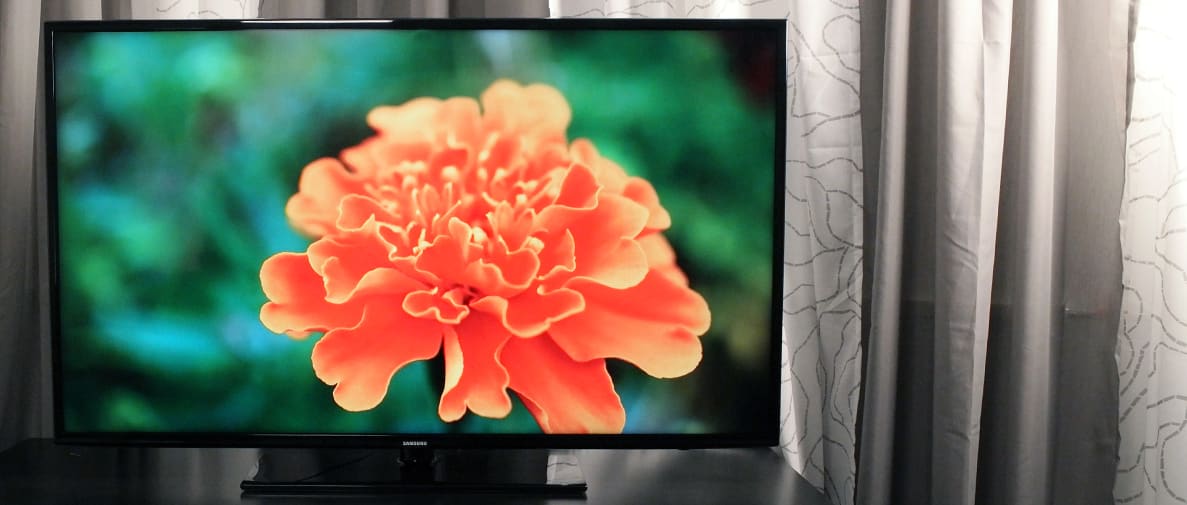The H6203 delivers solid performance: accurate colors, decent contrast, and reliable motion thanks to its 120 Hz panel. Its out-of-the-box picture quality isn't the best we've seen this year, but with a little tweaking it can look just as good as some of Samsung's higher-end offerings. From a pure performance standpoint, the H6203 is a fine choice at a low price.
Technophiles and impatient people may want to spring for something a little more high-end, however, as this TV doesn't offer the smoothest user experience. The software occasionally grinds to a sputtering halt when multitasking, which is sure to frustrate particular users.
If you're not too picky about software functionality, though, the H6203 (currently available for about $800) is a good choice if you just want a big, bright, color-rich picture that goes easy on frills.
The Looks
No molds broken
The H6203 looks very similar to many other Samsung options this year. Narrow black bezels wrap the screen and transition into a black aluminum backplate. The wide rectangular stand provides sturdy support, but doesn't allow the panel to swivel like in recent years. For a 2014 model, the H6203 isn't particularly thin—offering instead a thicker, more durable-looking profile.
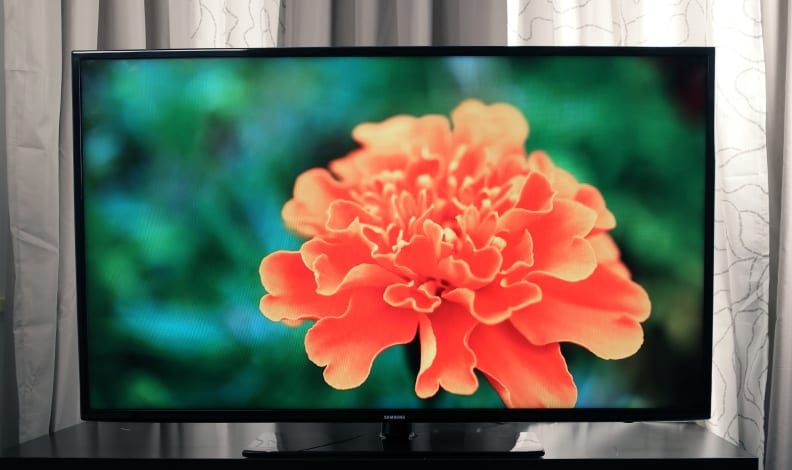
The H6203 isn't going to turn too many heads, but it offers a traditional look that puts heavy emphasis on the big screen.
On the back of the TV, you'll find a decent spread of connectivity options, though the amount of inputs are scaled back compared to the H6350, a series that's just one step above this one.
Ports include two HDMI inputs, two USB inputs, an ethernet (LAN) cable, shared component/composite jacks, a coaxial jack for cable/antenna, digital and analog audio out (headphones), IR out for the included IR blaster, and an RS-232c control port.
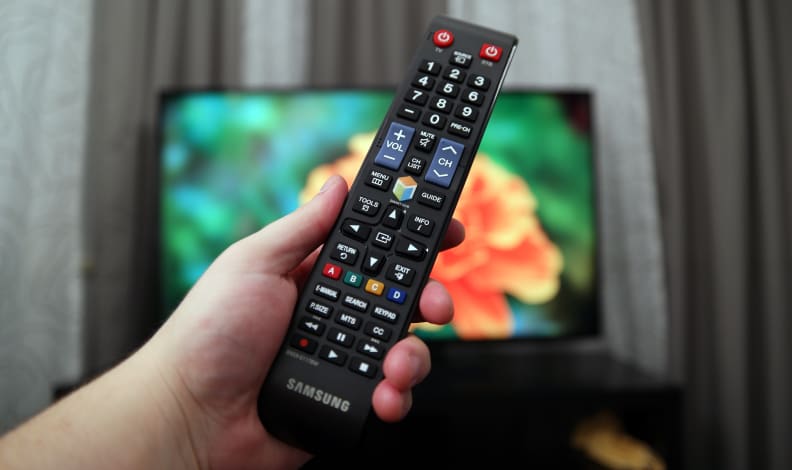
The included remote is long and full of buttons. It works well, but the TV's actual responsiveness leaves a bit to be desired.
You don't get a ton of goodies in the box, but all the necessities are in tow. The included remote control works well and includes more buttons than most users will ever need. There's also an IR extension cable that you can plug into the TV's IR port to directly control your set-top-box. This works alongside the TV's cable integration, which populates the Smart Hub with your programming info.
{{ photo_gallery "design" }}
The Experience
Plenty of software options, but a very gimped version of the Smart Hub
LG's webOS platform may have taken our award for Best Smart TV Platform of 2014, but Samsung's Smart Hub is still one of our favorites. The H6203 features a truncated version that's apps only—no web browser, games, or any of the sprawling content that the full Smart Hub contains. This isn't necessarily a bad thing: Apps are the best thing about smart TVs, after all.
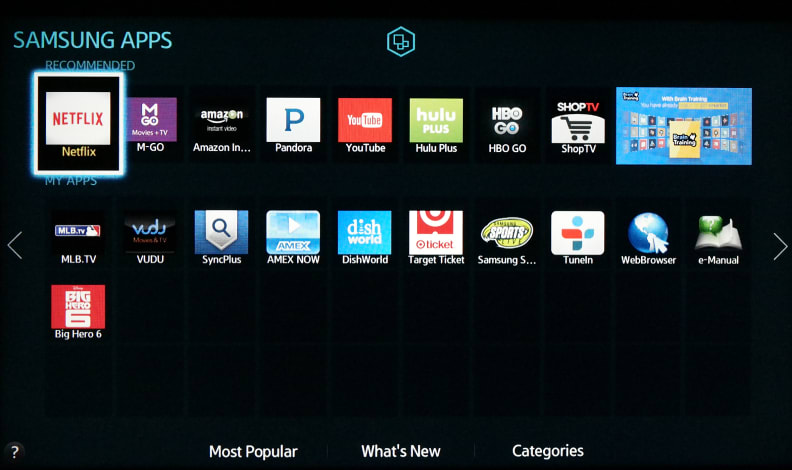
Unless you play to integrate your cable or satellite content, the H6203 only features a single Smart Hub tab for apps, excluding the TV, movie, and game content found in the full Smart Hub.
On the other hand, the picture and audio menus are just as fleshed out as ever. Sub-menus for Picture, Audio, or Network settings make it easy to select from pre-set picture modes—such as Dynamic, Standard, and Movie—or to set up a wireless internet connection. D.I.Y. calibrators will relish the included white balance and color management options, as well.
Compared to other mid-range Samsungs, the H6203 feels a little undercooked in the software and functionality department. The most popular apps are all here, though, and no one's going to miss the web browser, especially since the TV doesn't include Samsung's browser-friendly Smart Touch controller.
Where the H6203 seems to fall short, however, is basic TV multi-tasking. I booted up Netflix to watch World War Z, only to realize the TV was still in Dynamic mode (which is simply too bright for a dark room). When I attempted to switch picture modes and adjust the picture settings, I found that the normally sleek software was extremely sluggish while Netflix was also running. It takes anywhere from 5-15 seconds for the menu to pop up, and scrolling through items is just as bad.
{{ photo_gallery "software" }}
The Picture
A beautiful image is this TV's strongest suit
The H6203 may not provide users with Samsung's fully fleshed-out Smart Hub—and it certainly doesn't do much to distinguish itself in terms of design or extra features—but the H6203 punches well above its weight class in terms of picture quality. It won't blow away seasoned cinephiles, but it's plenty good enough for most users.
Testing revealed rich color fidelity, decent contrast, and good motion performance thanks to the TV's 120 Hz refresh rate. A full calibration left the TV looking as good as some of Samsung's high-end options, but the out-of-the-box settings in the Movie picture mode are plenty accurate for most viewers, too. Solid black levels mean the H6203 is shadowy enough for dark room viewing, but it's easily bright and colorful enough to combat ambient lighting, especially in Dynamic mode.
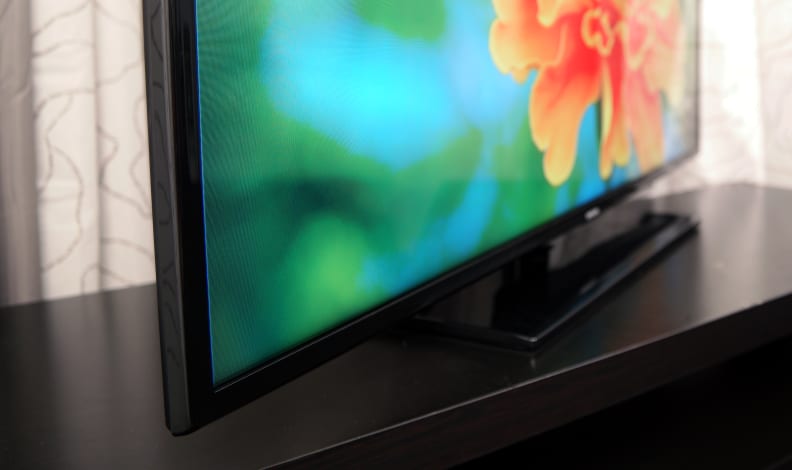
The H6203 boasts rich, accurate colors, good motion performance, decent contrast, and enough controls to calibrate it to ideal standards.
I recommend that interested consumers use this TV in a room with normal ambient lighting, as it suffers from slight uniformity issues that are much more obvious when you're watching in total darkness. For my sample unit, the lower left corner was notably brighter/bluer than the rest of the screen, which was especially visible during letterbox (16:9) style content. With a couple of lamps on, however, I couldn't see the backlight bleed at all.
If you're a sports or action movie lover, you'll probably want to make use of Samsung's Auto Motion Plus mode, which allows for mild de-blurring of fast action content. This kind of frame interpolation looks a little bizarre for standard 24p film content, but is great for smoothing out the blurring commonly associated with broadcast sports like football or hockey. Likewise, if you're a gamer struggling with input lag, flip on Game mode in General settings in the System sub-menu.
Overall, the H6203 provides solid performance for an edge-lit LCD TV. It doesn't have the contrast efficacy of a full-array or plasma set, but it provides a very pleasing image nonetheless. considering its pedigrees. Just don't mount it on the wall—the viewing angle isn't bad, but doesn't have the flexibility necessary for a wall-mounted display.
For more info on our lab results and calibration settings, check out the Science Page.
The Verdict
A solid value at the right price, but not the best option on the market
Simply put: This isn't the TV to pick if you want the flashiest, fanciest option on the market. What Samsung's done here is take its typical mid-range LED, cutting costs and features where possible. For the $1,500 MSRP this would be atrocious, but at the $800 street price this TV typically sells for it's actually a great deal for you.
Sure, the Smart Hub is missing a number of features—DLNA support, a web browser, and Samsung's usual suite of built-in games—but those are features you're unlikely to miss anyway. Just about the only drawback of this strategy is that the TV is slow; the sluggish software wore my nerves pretty thin, and I actually like messing around in TV menus.
I wouldn't want this as the centerpiece of my state-of-the-art home theater, but for about $800 online the H6203 is a great 1080p value for users looking to keep things simple. We've got no complaints about the rich colors, decent contrast, and reliable motion performance this set provides.
On the other hand, you can find the 55-inch Vizio E Series—a full-array backlit LCD TV with similar smart features—for a similar price. The E Series provides better contrast and backlight uniformity. It also struggles less with its own software, though it lacks this Samsung's color vivacity and overall build quality.
Whatever you do, don't pay the $1,500 list price—for that amount of money, you could get a considerably nicer TV.
Behind The Screens
The Samsung UN55H6203 (MSRP $1,599.99) is a performer first and foremost. The software may be sluggish and the design may bore you to tears, but the panel quality is very reliable. Time in the lab revealed accurate Rec. 709 (standard) HD colors, with a little extra in Native mode, plus decent contrast and good detail retention during motion. One small backlight blemish made dark-room viewing a bad idea, but it disappeared with a couple of lights on. The H6203 is quite bright and colorful, and with a bit of calibration can look as good as much more expensive sets. Read on to see our lab results and calibration settings.
Calibration
We measure a TV's performer both prior to and after an ISF-certified calibration process involving a multitude of test patterns and light meters. The end result provides valuable information on the TV's out-of-the-box fidelity, as well as how far an informed calibration session will take it. The H6202, like most 2014 Samsungs, gives users access to 2- and 10-point white balance controls, color adjustments, and a gamma slider to aid in the calibration process.
I performed a dark room calibration with this set, though it's probably better off calibrated to a room with normal or higher amounts of ambient lighting. Our dark room parameters involve a reference white of 40 fL (or about 120 nits) and a flat gamma curve of 2.4. Below, you'll the default settings for Movie mode alongside my final calibrated settings.
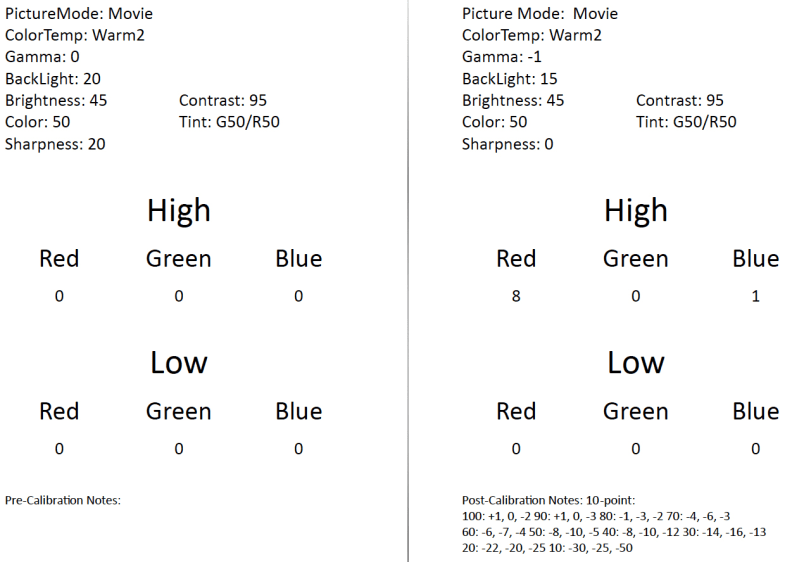
Samsung's default settings in Movie mode on the right, and our final calibrated settings on the left.
Contrast Ratio
A TV's contrast ratio is determined by dividing its reference white (100 IRE luminance) by its minimum luminance level, or black level. Televisions with very high contrast ratios offer a more immersive viewing experience, as the space between the brightest and darkest elements creates an appearance of depth and shadow gradation. You want the biggest contrast ratio you can get, especially for movie or film content.
The H6203 is a decent performer here, though we've seen better black levels this year. Using a standard ANSI checkerboard pattern, I measured a black level of 0.07 cd/m2 and a reference white of 170 cd/m2 . During our contrast falloff tests, I also measured black levels as deep as 0.05 cd/m2 , though only when the majority of the screen was black. This gives the H6203 an ANSI contrast ratio of 2429:1, which is decent, but falls short of some comparably priced LCDs.
On the plus side, these black levels are plenty dark for dim lighting, but the TV is easily bright enough to combat a sunny room, giving the H6203 a good amount of flexibility.

The H6203 is a decent performer in terms of contrast, though it falls a bit short of its peers.
Viewing Angle
Our viewing angle test measures the horizontal viewing flexibility of a TV's screen, determining how far from head-on you can watch it before the picture becomes compromised. LCD TVs tend to struggle here, as the layout of the LCD panel and transistors behind the screen reduce the effusiveness of the backlight, resulting in blacks that get brighter and whites that get dimmer as you move into more and more obtuse off angles.
The H6203 is an average performer for an LCD, meaning it's viewing angle is quite narrow compared to comparable plasma and OLED models. I measured a total viewing angle of 37‡, or ±18.5° from the center to either side of the screen. This is roughly the same result as comparison products from competitors LG, Panasonic, and Vizio. You can spread out a bit while you watch the H6203, but don't plan on mounting it on a wall.
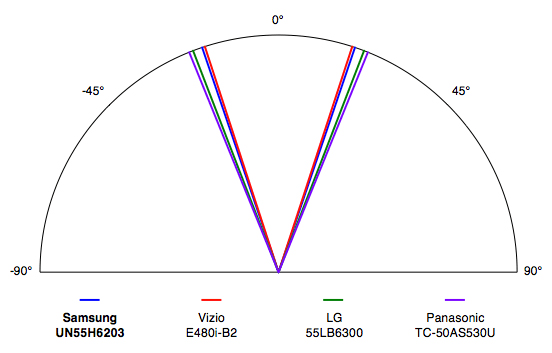
For an LCD TV, the H6203 offers an average horizontal viewing angle. You can spread out while you watch, but don't wall-mount it.
Color Gamut
A color gamut is a visual representation of all the colors a TV can create. Back in the day, the International Telecommunications Union (ITU) created a document called Rec. 709 that specifies the exact hue/saturation of white, red, blue, green, cyan, magenta, and yellow light that HDTVs should create for maximum artistic integrity. When testing a TV's color, we compare its exact hue/saturation measurements with the Rec. 709 ideals.
While I noticed very small, mostly imperceptible errors in the H6203's green and blue production—red, too, could be a little more saturated out-of-the-box—for the most part, the H6203 produces very accurate colors, at least in Movie mode. Color fidelity and subtler gradations all looked very good during movie content. Overall, this is one of the TV's strongest assets.
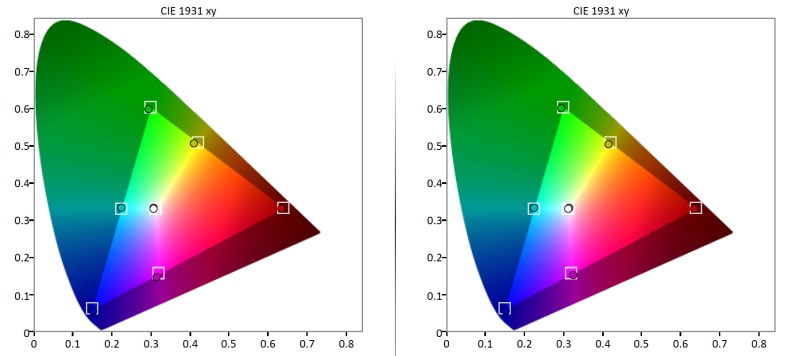
Other than a few very minor errors, the H6203 produces very accurate color right out-of-the-box, with no calibration necessary.
Grayscale & RGB Balance
A TV's grayscale refers to its black, gray, and white neutral elements. Because TV's follow an additive color scheme, grayscale elements are produced by light that passes through three color filters simultaneously: red, green, and blue. When these three colors are emphasized properly, the TV's white balance is correct per the same Rec. 709 requirements that dictate accurate color. In this case, grayscale elements should adhere to exact CIE 1931 coordinates, where x = ~0.313, y = ~0.329. Perceptible deviation from this requirement results in visible error, measured in a collective called DeltaE. A DeltaE of 3 or less is considered ideal.
Out of the box, the H6203 tested with a grayscale DeltaE of 4.1, which is a little higher than the ideal error, but also isn't much to complain about. Using the TV's 2- and 10-point white balance controls, I reduced the DeltaE to 1.5 during calibration.

The H6203 tested with a grayscale DeltaE of 4.1 in Movie mode.
During testing and calibration, we also measure the balance between the three color filters, otherwise known as RGB balancing. Prior to calibration, our H6203 under-emphasized the red filter, causing the green and blue filters to receive too much emphasis. Using the TV's white balance controls, I added red into the high (gain) half of the grayscale, and made minute adjustments using the 10-step control to achieve a better balance.
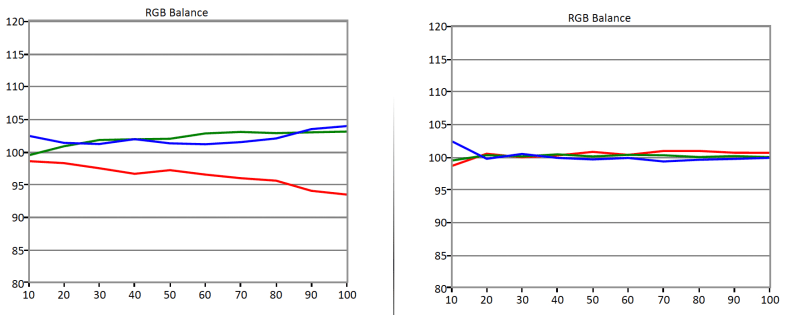
By increasing the presence of red in the grayscale balance, I was able to balance the H6203's white balance closer to the ideal coordinates.
Gamma
Gamma refers to how quickly (or slowly) a TV adds luminance at each analog step (IRE) from minimum black to reference white. TVs ideally adhere to a gamma of 2.2, 2.3, or 2.4, depending on the lighting situation and viewing environment. During calibration, we aim for a flat 2.4 gamma, currently the best choice for a pitch-black home theater environment.
By default, the H6202 followed a mostly flat gamma curve of 2.23, which is quite close to the 2.2 ideal. During calibration, it was easy to push the TV down to a darker room gamma of 2.4 by moving the gamma slider from 0 to -1 and making the appropriate luminance adjustments during white balancing. Only the lowest step (10 IRE) continued to show some error, mostly due to overemphasis of the blue color filter (or sub-pixel).
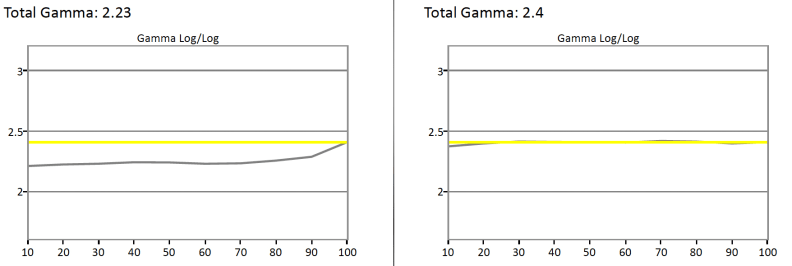
After calibration, the H6203 adhered to a (mostly) flat gamma curve of 2.4, ideal for a dark room.
Meet the tester
Lee was Reviewed's point person for most television and home theater products from 2012 until early 2022. Lee received Level II certification in TV calibration from the Imaging Science Foundation in 2013. As Editor of the Home Theater vertical, Lee oversaw reviews of TVs, monitors, soundbars, and Bluetooth speakers. He also reviewed headphones, and has a background in music performance.
Checking our work.
Our team is here to help you buy the best stuff and love what you own. Our writers, editors, and experts obsess over the products we cover to make sure you're confident and satisfied. Have a different opinion about something we recommend? Email us and we'll compare notes.
Shoot us an email